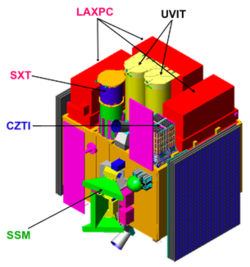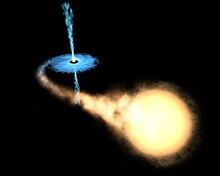AstroSat
 | |
| COSPAR ID | 2015-052A |
|---|---|
| SATCAT no. | 40930 |
| Website | [1] |
| Start of mission | |
| Launch date | 2011[1] |
Astrosat is India's first dedicated astronomy satellite and is scheduled to launch on board the PSLV in 2011 After the success of the satellite-borne Indian X-ray Astronomy Experiment (IXAE), which was launched in 1996, the Indian Space Research Organization (ISRO) has approved further development for a full fledged astronomy satellite - Astrosat.
A large number of leading astronomy research institutions in India and abroad are jointly building various instruments for the satellite. Important areas requiring broad band coverage include studies of astrophysical objects ranging from the nearby solar system objects to distant stars, to objects at cosmological distances; timing studies of variables ranging from pulsations of the hot white dwarfs to active galactic nuclei(AGN)with time scales ranging from milliseconds to few hours to days.
Astrosat is currently proposed as a multi-wavelength astronomy mission on an IRS-class satellite into a near-Earth, equatorial orbit by the PSLV. The 5 instruments on-board cover the visible (320-530 nm), near UV(180-300 nm), far UV(130-180 nm), soft X-ray (0.3-8 keV and 2-10 keV) and hard X-ray (3-80 keV and 10-150 keV) regions of the electromagnetic spectrum.
Mission

Astrosat will be a proposal-driven general purpose observatory, with main scientific focus on:
- Simultaneous multi-wavelength monitoring of intensity variations in a broad range of cosmic sources
- Monitoring the X-ray sky for new transients
- Sky surveys in the hard X-ray and UV bands
- Broadband spectroscopic studies of X-ray binaries, AGN, SNRs, clusters of galaxies and stellar coronae
- Studies of periodic and non-periodic variability of X-ray sources
Astrosat will carry out multi-wavelength observations covering spectral bands from radio, optical, IR, UV, X-ray and Gamma ray regions both for study of specific sources of interest and in survey mode. While radio, optical, IR observations would be coordinated through ground-based telescopes, the high energy regions, i.e., UV, X-rays and Gamma rays would be covered by the dedicated satellite borne instrumentation of Astrosat.[2]
The mission would also study near simultaneous muti-wavelength data from different variable sources. In a binary system for example regions near the compact object emit predominantly in X-rays, the accretion disc emitting most of its light in the UV/ optical waveband, and the mass donating star being brightest in the optical band.
The observatory will also carry out (a) low to moderate resolution spectroscopy over wide energy band with the primary emphasis on studies of X-ray emitting objects, (b) Timing studies of periodic and aperiodic phenomenon in X-ray binaries, (c) Studies of pulsations in X-ray pulsars, (d) QPOs, flickering. Flaring and other variations in X-ray binaries, (e) short and long term intensity variations in AGNs, (f) time lag studies in low/hard X-rays and UV/optical radiation, (g) detection and study of x-ray transients.[3] In particular, the mission will train its instruments at active galactic nuclei at the core of the Milky Way that is believed to have a super massive black hole.[4]
Payloads
The scientific payload has a total mass of 750 kg and contains six instruments.
- The UltraViolet Imaging Telescope (UVIT) - The UltraViolet Imaging Telescope will perform imaging simultaneously in three channels: 130-180 nm, 180-300 nm, and 320-530 nm. The field of view is a circle of ~ 28 arcmin diameter and the angular resolution is 1.8" for the ultraviolet channels and 2.5" for the visible channel. In each of the three channels a spectral band can be selected through a set of filters mounted on a wheel; in addition, for the two ultraviolet channels a grating can be selected in the wheel to do slitless spectroscopy with a resolution of ~ 100.
- Soft X-ray imaging Telescope (SXT)- The soft X-ray telescope on Astrosat will employ focussing optics and a deep depletion CCD camera at the focal plane to perform X-ray imaging in 0.3-8.0 keV band. The optics will consist of 41 concentric shells of gold-coated conical foil mirrors in an approximate Wolter-I configuration. The focal plane CCD camera will be very similar to that flown on SWIFT XRT. The CCD will be operated at a temperature of about -80oC by thermoelectric cooling.
- The LAXPC Instrument - For X-ray timing and low-resolution spectral studies over a broad energy band (3-80 keV) Astrosat will use a cluster of 3 co-aligned identical Large Area X-ray Proportional Counters (LAXPCs), each with a multi-wire-multi-layer configuration and a Field of View of 1o X 1o. These detectors are designed to achieve (I) wide energy band of 3-80 keV, (II) high detection efficiency over the entire energy band, (III) narrow field of view to minimize source confusion, (IV) moderate energy resolution, (V) small internal background and (VI) long life time in space.
- Cadmium Zinc Telluride Imager (CZTI) - Astrosat will carry a hard X-ray imager in the form of CZTI. It will consist of a Pixellated Cadmium-Zinc-Telluride detector array of ~1000 cm2 geometric area. These detectors have very good detection efficiency, close to 100% up to 100 keV, and have a superior energy resolution (~2% at 60 keV) compared to scintillation and proportional counters. Their small pixel size also facilitates medium resolution imaging in hard x-rays. The CZTI will be fitted with a two dimensional coded mask, for imaging purposes. The sky brightness distribution will be obtained by applying a deconvolution procedure to the shadow pattern of the coded mask recorded by the detector.
- Scanning Sky Monitor (SSM) - The Scanning Sky Monitor will consist of three position sensitive proportional counters, each with a one-dimensional coded mask, very similar in design to the All Sky Monitor on NASA's RXTE satellite. The gas-filled proportional counter will have resistive wires as anodes. The ratio of the output charge on either ends of the wire will provide the position of the x-ray interaction, providing an imaging plane at the detector. The coded mask, consisting of a series of slits, will cast a shadow on the detector, from which the sky brightness distribution will be derived.
- Charged Particle Monitor (CPM) - A charged particle monitor (CPM) will be included as a part of Astrosat payloads to control the operation of the LAXPC, SXT and SSM. Even though the orbital inclination of the satellite will be 8 deg or less, in about 2/3rd of the orbits, the satellite will spend a considerable time (15 – 20 minutes) in the South Atlantic Anomaly (SAA) region which has high fluxes of low energy protons and electrons. The high voltage will be lowered or put off using data from CPM when the satellite enters the SAA region to prevent damage to the detectors as well as to minimize ageing effect in the Proportional Counters.
Ground support
The Ground Command and Control Centre for Astrosat will be located at ISTRAC, Bangalore, India. Commanding and data download will be possible during every visible pass over Bangalore. Ten out of 14 orbits per day will be visible to the ground station. The satellite is capable of gathering 420 gigabits of data every day that can be down loaded in 10 to 11 orbits visible at Tracking and Data receiving center of ISRO in Bangalore.[5]
Current status
Scientists from Tata Institute of Fundamental Research (TIFR) have completed the developmental phase of complex science payloads and have begun integrating them before delivery of the 1,650 kg satellite Astrosat. The challenges in the design of payloads and Attitude Control System have been overcome and in a recent review committee meeting, it was decided that the delivery of the payload to ISRO satellite Centre will begin from the middle of 2009 and continue till early 2010 to enable the launch of ASTROSAT in 2010 using ISRO workhorse PSLV.[6]
A third 11-meter antenna at the IDSN is under construction specifically for the Astrosat mission. It will be operational by 2009.
Participants
The Astrosat project is a collaborative effort of a growing list of research institutions. The current participants are:
- Indian Space Research Organization
- Tata Institute of Fundamental Research, Mumbai
- Indian Institute of Astrophysics, Bangalore
- Raman Research Institute, Bangalore
- Inter-University Centre for Astronomy and Astrophysics, Pune
- Bhabha Atomic Research Centre, Mumbai
- S.N. Bose National Centre for Basic Sciences, Kolkata
- Canadian Space Agency
- University of Leicester[7]
See also
References
- ^ www.aprsaf.org
- ^ India plans for X-ray spacecraft 2009 launch
- ^ http://www.isro.org/scripts/futureprogramme.aspx
- ^ http://kuku.sawf.org/News/57791.aspx
- ^ http://meghnad.iucaa.ernet.in/~astrosat/home.html
- ^ http://www.livemint.com/2009/04/22123907/ASTROSAT-to-be-launched-in-mid.html
- ^ India Works With University Of Leicester On First National Astronomy Satellite

